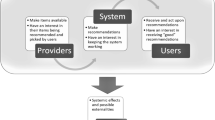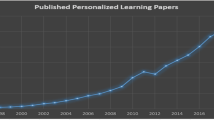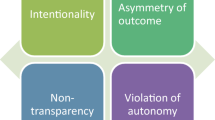Abstract
In this paper we describe the evaluation of a personalised information system for patients with cancer. Our system dynamically generates hypertext pages that explain treatments, diseases, measurements etc related to the patient's condition, using information in the patient's medical record as the basis for the tailoring. We describe results of a controlled trial comparing this system with a nonpersonalised one. The results of the trial slow significant results concerning the patients' preferences for personalised information. We discuss the implications of our evaluation and results for the development and evaluation of future personalised systems, and adaptive hypertext systems in particular.
Similar content being viewed by others
References
Becker, H. (ed.): 1974, The health belief model and personal health behavior. Thorofare, N.J., C.B. Slack.
Bental, D., Cawsey, A. and Jones, R.: 1999, Patient information systems that tailor to the individual. Patient Education and Counselling 36(2), 171–180.
Binsted, K., Cawsey, A. and Jones, R.: 1995, Generating personalised information using the medical record. In: Artificial Intelligence in Medicine: Proceedings of AIME 95. Berlin, Springer-Verlag, pp. 29–41.
Boyle, C. and Encarnacion, A.: 1994, Metadoc: An adaptive hypertext reading system. User Modeling and User-Adaptive Interaction 4(1), 1–19.
Brusilovsky, P. and Pesin, L.: 1998, Adaptive navigation support in educational hypermedia: An evaluation of ISIS-Tutor. Journal of Computing and Information Technology 6(1), 27–38.
Buchanan, B., Moore, J., Forsythe, D., Carenini, G., Ohlsson, S. and Banks, G.: 1995, An intelligent interactive system for delivering individualized information to patients. Artificial Intelligence in Medicine 7(2), 117–154.
Campbell, M., De Vellis, B., Strecher, V., Ammerman, A., DeVellis, R. and Sandler, R.: 1994, Improving dietary behaviour: The efficacy of tailored messages in primary care settings. American Journal of Public Health 84(5), 783–787.
Cawsey, A., Bental, D., Jones, R., Pearson, J. and Carter, E.: 1998, A personalised patient information system using GRAIL. In B. Richards (ed.), Current Perspectives in Healthcare Computing 1998. BJHC Limited, pp. 115–121.
Dale, R., Oberlander, J., Milosavljevic, M. and Knott, A.: 1998, Integrating natural language generation with hypertext to produce dynamic documents. Interacting with Computers 11(2), 109–135.
Draper, S.: 1997, The prospects for summative evaluation of CAL in HE. Association of Learning Technology Journal (ALT-J) 5(1), 33–39.
Eklung, J. and Brusilovsky, P.: 1998, The value of adaptivity in hypermedia learning environments: A short review of the empirical evidence. In: P. Brusilovsky and P. de Bra (eds.), Second Workshop on Adaptive Hypertext and Hypermedia (Hypertext' 98). pp. 13–20.
Fallowfield, L., Ford, S. and Lewis, S. 1995, No news is not good news: Information preferences of patients with cancer. Psycho-Oncology 4, 197–202.
Fredette, S.: 1990, A model for improving cancer patient eduction. Cancer Nursing 13(4), 207–215.
Gillespie, M. and Ellis, L.: 1993, Computer-based patient education revisited. Journal of Medical Systems 17(3-4), 119–125.
Grasso, F.: 1998, Exciting avocados and dull pears: Combining behavioural and argumentative theory for producing effective advice. In: Proceedings of the 20th Annual Meeting of the Cognitive Science Society. pp. 436–441.
Haimowitz, I.: 1991, Modeling all dialogue system participants to generate empathetic responses. Computer Methods & Programs in Biomedicine 35(4), 321–330.
Hathaway, D.: 1986, Effect of preoperative instruction on postoperative outcomes: A meta-analysis. Nursing Review (35), 269–275.
Hirst, G., DiMarco, C., Hovy, E. and Parsons, K.: 1997, Authoring and generating health-education documents that are tailored to the needs of the individual patient. In: A. Jameson, C. Paris and C. Tasso (eds.), Proceedings of the Sixth International Conference on User Modeling. Springer, pp. 107–118.
Hitzeman, J., Mellish, C. and Oberlander, J. 1997, Dynamic generation of museum web pages: The intelligent labelling explorer. Archives and Museum Informatics 11, 107–115.
Jimison, H., Fagan, L., Shachter, R. and Shortliffe, E.: 1992, Patient-specific explanation in models of chronic disease. Artificial Intelligence in Medicine 4, 192–205.
Jones, R., Campbell, G., Navin, L., Ritchie, J. and Kelly, M.: 1992, Touch-screen multi-media systems for patients and health education. In: Proceedings of the Second Asia-Pacific Medical Informatics Conference, pp. 311–318.
Jones, R., Pearson, J., Cawsey, A. and Barrett, A.: 1996, Information for patients with cancer. Does personalisation make a difference. Pilot study results and randomised trial in progress. In: Proceedings of the AMIA Fall Symposium, pp. 423–427.
Jones, R., Pearson, J., McGregor, S., Cawsey, A., Barrett, A., Craig, N., Atkinson, J., Gilmour,W. and McEwen, J.: 1999a, Randomised trial of computer-based information for outpatients with cancer. Does personalisation of the information presented, using the medical record, make a difference? British Medical Journal (submitted).
Jones, R., Pearson, J., McGregor, S., Gilmour, W., Atkinson, J., Barrett, A., Cawsey, A. and McEwen, J.: 1999b, Patients underoing radiotherapy treatment for cancer who are dissatisfied with the information they have received. British Medical Journal (submitted).
Kobsa, A., Müller, D. and Hill, A.: 1994, KN-AHS: An adaptive Hypertext client of the user modeling system BGP-MS. In: Procedings of the 4th International Conference on User Modeling, Hyannis, Mass. pp. 99–105.
Krause, J., Mittermaier, E. and Hischmann, A.: 1993, The intelligent help system COMFOHELP. User Modeling and User-Adapted Interaction 3, 249–282.
Lyons, C., Krasnowski, J., Greenstein, A., Maloney, D. and Tatarczuk, J.: 1982, Interactive computerized patient education. Heart and Lung 11(4), 340–341.
Mark, M. and Greer, J.: 1993, Evaluation methodologies for intelligent tutoring systems. Journal of Artificial Intelligence in Education 4(2/3), 129–153.
Marshall, W., Rothberger, L. and Bunnell, S.: 1984, The efficacy of personalised audiovisual patient education materials. Journal of Family Practice 19, 659–663.
McGarry, E., Jones, R., Cowan, B. and White, J.: 1998, A multimedia system for personalized treatment of anxiety in primary care. In: B. Richards (ed.), Healthcare Computing 1998. BJHC Books, pp. 277–285.
McRoy, S., Liu-Perez, A. and Ali, S.: 1998, Interactive computerized health care education. Journal of the American Medical Informatics Association 5(4), 347–356.
Meredith, C., Symonds, P., Webster, L., Lamont, D., Pyper, E., Gilles, C. and Fallowfield, L.: 1996, Information needs of cancer patients in west Scotland: Cross sectional survey of patients' views. British Medical Journal 313, 724–726.
Morris, J., Goddard, M. and Roger, D: 1989, The Benefits of Providing Information to Patients. Technical Report 58, Center for Health Economics, University of York.
Osman, L., Abdulla, M., Beattie, J., Ross, S., Russell, I., Friend, J., Legge, J. and Douglas, J.: 1994, Reducing hospital admission through computer-supported education for asthma patients. British Medical Journal 308, 568–571.
Poroch, D.: 1995, The effect of preparatory patient education on the anxiety of cancer patients receiving raiation therapy. Cancer Nursing 18, 206–214.
Prochaska, J. and DiClemente, C.: 1992, Stages of change in the modification of problem behavior. In: M. Hersen, R. Eisler, and P. Miller (eds.), Progress in Behavior Modification, Vol. 28. Sycamore, IL, Sycamore Publishing Company.
Read, J.: 1993, Coding and classification in health and medical care systems. In: A. Hedley (ed.), Proceedings of the second Hong Kong (Asia-Pacific) Medical Informatics Conference. Hong Kong, Hong Kong Society of Medical Informatics Ltd, pp. 175–180.
Rector, A., Zanstra, P., Solomon, W. and the Galen consortium: 1995, GALEN: Terminology services for clinical information systems. In: M. Lairs, M. Ladeira and J. Christensen (eds.), Health in the New Communications Age: Health Care Telematics for the 21st Century. IOS Press, pp. 90–100.
Reiter, E. and Mellish, C. 1992, Using classification to generate text. In: Proceedings of the 30th Annual Meeting of the Association for Computational Linguistics, pp. 265–272.
Reiter, E. and Mellish, C.: 1993, Optimizing the costs and benefits of natural language generation. In: Proceedings of the 13th International Conference on Artificial Intelligence (IJCAI-1993), pp. 1164–1169.
Reiter, E., Mellish, C. and Levine, J.: 1995, Automatic generation of technical documentation. Applied Artificial Intelligence 9(3), 259–287.
Reiter, E. and Osman, L.: 1997, Tailored patient information: some issues and questions. In: Proceedings of the ACL-1997 Workshop on From Research to Commercial Applications: Making NLP Technology Work in Practice, pp. 29–34.
Schwartz, L. and Brenner, Z.: 1979, Critical care unit transfer: reducing patient stress through nursing interventions. Heart Lung (8), 540–547.
Shute, V.: 1993, Principles for evaluating intelligent tutoring systems. Journal of Artificial Intelligence in Education 4(2/3), 245–271.
Shute, V.J. 1995, SMART: Student modeling approach for responsive tutoring. User Modeling and User-Adapted Interaction 5(1), 1–44.
Strachan, L., Anderson, J., Sneesby,M. and Evans, M.: 1997, Pragmatic user modelling in a commercial software system. In: A. Jameson, C. Paris and C. Tasso (eds.), User Modeling: Proceedings of the Sixth International Conference, UM97. Vienna, New York, Springer, Wien, New York, pp. 189–200. Available from http://um.org.
Strecher, V.J., Kreuter, M., Boer, D.-J.D., Kospers, S., Hospers, H. and Skinner, C.S.: 1994, The effects of computer-tailored smoking cessation materials in family practice settings. The Journal of Family Practice 39(3), 262–270.
Twidale, M.: 1993, Redressing the balance: The advantages of information evaluation techniques for Intelligent Learning Environments. Journal of Artificial Intelligence in Education 4(2/3), 155–178.
Author information
Authors and Affiliations
Rights and permissions
About this article
Cite this article
Cawsey, A.J., Jones, R.B. & Pearson, J. The Evaluation of a Personalised Health Information System for Patients with Cancer. User Modeling and User-Adapted Interaction 10, 47–72 (2000). https://doi.org/10.1023/A:1008350913145
Issue Date:
DOI: https://doi.org/10.1023/A:1008350913145




